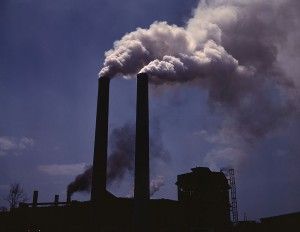Flawed study tries to link smog with childhood cancer
By Wayne Lusvardi
Anyone who remembers the choking smog of 1960s Los Angeles knows of the great advances since then in cleaning the air. But as Nobel economist Milton Friedman once quipped, “Nothing is so permanent as a temporary government program.”
To keep “temporary” programs going, and to advance new programs such as the state’s new cap-and-trade program to reduce carbon emissions, reasons must be found.
Researcher Julia Heck at the UCLA Fielding School of Public Health recently found a “possible” link between proximity to traffic-related air pollution and a few childhood cancers.
The UCLA study looked at 3,590 children who were born in California from 1998 to 2007 and had cancer. A control group was selected at random from birth data on 80,224 children born in California. A control group is used for comparison purposes to determine if a study’s conclusions are valid.
To analyze the selected data, the UCLA researchers used a standard statistical analysis program called CALINE4 used by the California Department of Transportation to assess carbon monoxide impacts near major arterial streets. This statistical tool was developed in response to the National Environmental Policy Act of 1969.
Questionable study methods and conclusions
Steve Milloy, who runs the blog junkscience.com, questioned the results of the study:
“If this association were true, there would have been a huge spike in childhood cancer during the 1950s and 1960s [when industry and car traffic grew and pollution was at its worst]. This is junk science because the weak statistical associations are based on unknown exposure data (exposure data is only guesstimated) and the biological implausibility of lumping different types of cancer together (i.e., if an exposure causes cancer, it probably causes one sort of cancer not all sorts).”
Australian statistician John Ray, PhD, who is the web master of the Food and Health Skeptic blog, pointed out on April 12 that there was no control group for social class in this study.
In other words, homes adjacent to freeways tend to be comprised of lower-income families that may have adults who smoke (poor people smoke more than those better off), have bad indoor air quality, or have greater hereditary cancers in the first place. In Los Angeles, a comparison group would be needed of, say, children from wealthier families that lived near the San Gabriel Mountains where smog concentrates but is not adjacent to freeways. No such comparison was conducted in this study to control for socio-economic effects.
Indoor and outdoor
Moreover, without separating the effects of indoor from outdoor air pollution the results of the study are highly dubious. Even the U.S. Environmental Protection Agency states, “[I]ndoor levels of pollutants may be 2 to 5 times — and occasionally more than 100 times — higher than outdoor pollutant levels.” Any environment that concentrates substances in the air or water is likely to lead to pollution. The first principle of toxicology is: “the dosage is the poison,” not the substance itself. Thus, it is more likely to be a lack of adequate building ventilation and filtering that leads to poor air quality.
The sampling and comparison methods used in the UCLA study were bogus because measuring differences in cancer rates between children who already had cancer and lived near freeways with all children born in California is going to result in a predetermined result. Concluding that there is a 100 percent correlation that apples and oranges are not the same is junk science. Thus, the statistical correlations found in the UCLA study are spurious.
A 2009 U.C. Davis study funded by the U.S. Highway Administration comparing the CALINE4 statistical model used in the UCLA study found: “CALINE4…resulted in over-prediction when incremental concentrations due to on-road emissions were low, while under-predictions occurred when incremental concentrations were high.” In other words, the statistical model used in the UCLA study has a built-in bias toward finding higher levels of pollution.
The largest and most credible study of child cancers and smog in California was conducted by Danish scholars in 2001, “Epidemiologic Evidence for Air Pollution and Childhood Cancer.” This study found no association between “traffic metrics and childhood cancer” in California.
Attempted link to cap-and-trade funding
The California Legislative Analysts Office has said that California’s cap-and-trade funds cannot be legally used as a slush fund to plug deficits in the state budget. But the LAO has said that funds can only be narrowly spent on programs that specifically reduce carbon emissions, not on medical programs that treat the purported negative health effects on children.
Even the U.C. Berkeley Center for Law, Energy, and the Environment concurred with the LAO that it would be too legally risky to try to use cap-and-trade funds to plug deficits in the General Fund budget. What the studies trying to link childhood cancer with traffic-related pollution are apparently trying to do is link smog and childhood cancers so cap-and-trade pollution funding can be authorized for Medi-Cal funding for lower-income families.
The media are reporting these studies as conclusive but the nonpartisan analysts are not.
Related Articles
Arnold Still Clueless
John Seiler: In office seven years, Gov. Arnold Schwarzendeficit still doesn’t realize why he couldn’t end the “crazy deficit spending”
State's health-mandate miasma
Feb. 2, 2010 By JOHN SEILER The victory of Scott Brown in Massachusetts prevents Democrats from enacting a universal health-care
CA rejects VW recall plan
Thanks to California regulators, Volkswagen hasn’t yet found a way out of worldwide trouble. Federal agencies have flexed their muscles in




